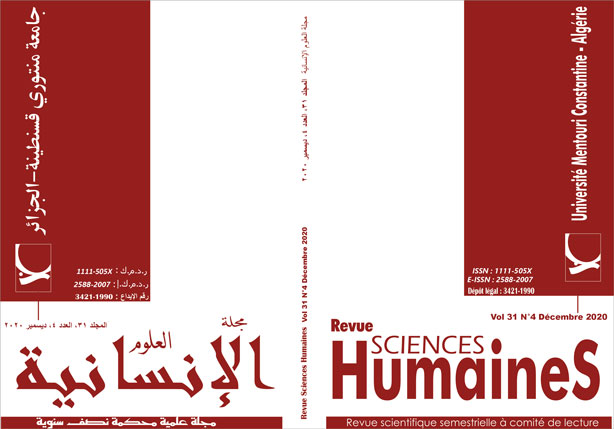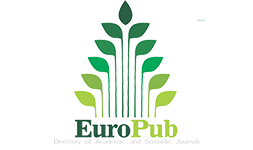Teachers’ Practices of Critical Thinking in the Algerian Secondary School EFL Classroom
الكلمات المفتاحية:
التفكير النقدي، تصنيف بلوم، التساؤل السقراطيالملخص
هناك اجماع حول الدور المحوري الذي يلعبه التفكير النقدي في الحياة الاكاديمية للأفراد. يدرس هذا البحث ممارسات الاساتذة لتفعيل التفكير النقدي في تعليم اللغة الانجليزية كلغة اجنبية بالطور الثانوي في الجزائر. ويهدف بشكل اساسي الى فحص تطبيق التفكير النقدي من خلال اجراءين: تصنيف بلوم وطرح الاسئلة السقراطية بافتراض انه إذا ما استخدم الاساتذة تصنيف بلوم والتساؤل السقراطي، فانه سيتم تفعيل التفكير النقدي وتعزيز. المهارات النقدية لدى المتعلمين. لتحقيق هذا الغرض من هذه الدراسة، تم توجيه استبيان الى 20 استاذ من الطور الثانوي. كشفت النتائج عن وعي الاساتذة بأهمية مهارات التفكير النقدي وفعالية استخدام تصنيف بلوم والتساؤل السقراطي في تعزيز التفكير النقدي لدى المتعلمين على الرغم من غياب إطار توجيهي وتحفيزي لتفعيله--
التنزيلات
المراجع
Apsari,N. (2016). Teachers’ Way to Foster Critical Thinking in the Classroom (a case study of a senior high school in Bandung). Journal of English and Education, volume 04 (1), 51-72
Asgharheidari, F.& Tahriri.A. (2015). A Survey of EFL Teachers’ Attitudes Towards Critical Thinking Instruction. Journal of Language Teaching and Research volume 06 (02). P.388.Doi 10.17507/jltr.0602.20.
Bloom,B. (1956) Taxonomy of Educational Objectives: The Classification of Educational Goals, Volume 1. D.Mckay, 1956.
Brookfield,S. (2011). Teaching for Critical Thinking and Techniques to Help Students Question their Assumptions. John Wiley & sons Inc.
Dewey, J.(1910). How we Think. Boston: DC. Health & Company. University of Michigan
Edmonds,M; Janik, E; and Rylance,K.(2005). History and Critical Thinking: A Handbook for Using Historical Documents to Improve Students’ Thinking Skills in the Secondary Grades. Madison: Wisconsin Historical Society;
Elder,L.&Paul,R.(2010). Critical Thinking Competency Standards Essential for the Cultivation of Intellectual Skills, Part.1. Journal of Developmental Education. 34(2),38.
Ennis,R.(1989). Critical Thinking and Subject Specificity, Clarification and Needed Research. Educational Researcher, 18(03). URL: https://www.jstor.org/stable/1174885
Ennis,R. (1992). Critical Thinking: A Streamlined Conception. The Palgrave Handbook of Critical Thinking in Higher Education, PP 31-47
Facione,P.(1989).Critical Thinking: A Statement of Expert Consensus for Purposes of Educational Assessment and Instruction. Facione and Insight Assessment. From:http://www.researchgate.net/publication/242279575-Critical-Thinking-A-Statement of Expert-Consensus-for Purposes-of Educational-Assessment-and Instruction
Fuquen Martinez, A. and Jimenez Nino, P.K (2013). Implementing Tasks that Stimulate Critical Thinking in EFL Classrooms. Cuadernos De Linguistica Hispanica, (21), 143- 158.
Mitchell,M.P.(2015). Metacognition: Nurturing Self-awareness in the Classroom. Retrieved May 28,2018. From http://www.edutopia.org
Murawski, L.M. (2014). Critical Thinking in the Classroom…and Beyond. Journal of Learning in Higher Education.10 (01).
Murray,M. (2006). Barriers High School Teachers Encounter in Teaching Critical Thinking in Writing. Walden University. Walden Dissertations and Doctoral Studies Collection. PP 16-19
Ni Putuayu, A.N. (2016). Teachers’ Way to Foster Critical Thinking in the Classroom (A Case Study of a Senior High School in Bandung). Journal of English and Education.2016, 4(1).PP.51-72
Omolara,S.R. and Adebukola,O.R.(2015). Teachers’ Attitudes: A Great Influence on Teaching and Learning Social Studies. Journal of Law, Policy and Globalisation.2015, 42:2224-3259.
Paul,R. and Elder,L.(2007). Critical Thinking Competency Standards.Strandards, Principles, Performance, Indicators, and Outcomes with a Critical Thinking Master Rubric. The Foundation for Critical Thinking Press.
Ragins,B.R., Cotton, J.L. (1999). Mentor Functions and Outcomes: A Comparison of Men and Women in Formal and Informal Mentoring Relationships. Journal of Applied Psychology,84 (1999, pp. 529- 550)
Rayhanul, I.S.M. (2015). What are the Importance and Benefits of Critical Thinking Skills?. Retrieved May11, 2020.
From http://www.linkedin.com/Pulse/what/importance/benefits/critical/thinking/skills/Islam
Sternberg,R.J.. Roediger,H.L,III, and Halpern, D.F.(Eds). (2007). Critical Thinking in Psychology. Cambridge University Press.
Sternberg, R.J; & Halpern,D.F.(2020). Critical Thinking in Psychology. Cambridge University Press.
Sullvian, J. (2020). How Does Bloom’s Taxonomy Relate to Critical Thinking Information? Retrieved June 15,2020, from : https://classroom,synonym.com/bloom-relate-critical-thinking-information-6233382.html
Tosuncuoglu,I. (2018). Place of Critical Thinking in EFL. International Journal of Higher Education. 7(4). Doi: 10.5430/ijhe. v7n4p26
Trushel,J.(n.d). What tutors Can do to Enhance Students’ Critical Thinking Skills Through the use of Bloom’s Taxonomy. The Association for the Tutoring Profession.
التنزيلات
منشور
كيفية الاقتباس
إصدار
القسم
الرخصة

هذا العمل مرخص بموجب Creative Commons Attribution-NonCommercial-ShareAlike 4.0 International License.
















